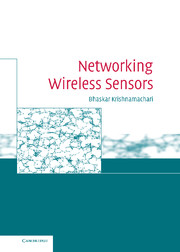Book contents
- Frontmatter
- Contents
- Preface
- 1 Introduction
- 2 Network deployment
- 3 Localization
- 4 Time synchronization
- 5 Wireless characteristics
- 6 Medium-access and sleep scheduling
- 7 Sleep-based topology control
- 8 Energy-efficient and robust routing
- 9 Data-centric networking
- 10 Transport reliability and congestion control
- 11 Conclusions
- References
- Index
5 - Wireless characteristics
Published online by Cambridge University Press: 14 August 2009
- Frontmatter
- Contents
- Preface
- 1 Introduction
- 2 Network deployment
- 3 Localization
- 4 Time synchronization
- 5 Wireless characteristics
- 6 Medium-access and sleep scheduling
- 7 Sleep-based topology control
- 8 Energy-efficient and robust routing
- 9 Data-centric networking
- 10 Transport reliability and congestion control
- 11 Conclusions
- References
- Index
Summary
Overview
Wireless communication is both a blessing and a curse for sensor networks. On the one hand, it is key to their flexible and low-cost deployment. On the other hand, it imposes considerable challenges because wireless communication is expensive and wireless link conditions are often harsh and vary considerably in both space and time due to multi-path propagation effects.
Wireless communications have been studied in depth for several decades and entire books are devoted to the subject [171, 207]. The goal of this chapter is by no means to survey all that is known about wireless communications. Rather, we will focus on three sets of simple models that are useful in understanding and analyzing higher-layer networking protocols for WSN:
Link quality model: a realistic model showing how packet reception rate varies statistically with distance. This incorporates both an RF propagation model and a radio reception model.
Energy model: a realistic model for energy costs of radio transmissions, receptions, and idle listening.
Interference model: a realistic model that incorporates the capture effect whereby packets from high-power transmitters can be successfully received even in the presence of simultaneous traffic.
Wireless link quality
The following is the basic ideal model of a wireless link: two nodes have a perfect link (with 100% packet reception rate) if they are within communication range R, and a non-existent link (0% packet reception rate) if they are outside this range.
- Type
- Chapter
- Information
- Networking Wireless Sensors , pp. 70 - 81Publisher: Cambridge University PressPrint publication year: 2005

